1900's fashion
Fashion in the period 1900 in European and European-influenced countries continued the long elegant lines of the 1890s. Tall, stiff collars characterize the period, as do women's broad hats and full "Gibson girl" hairstyles.
 |
| "Gibson Girls" Hairstyles (1900's) |
 |
| Stiff structure |
The S-Curve-
The silhouette softened into the S-shaped curve with softer shoulders, less restrictive corsets and the bustle never returned.
The three piece suit for gentlemen was introduce. The suit was non constricting with a sack coat, simple vest, and pleated trousers relatively and in 1906 the permanent wave was developed.
 |
| 1900's woman's fashion |
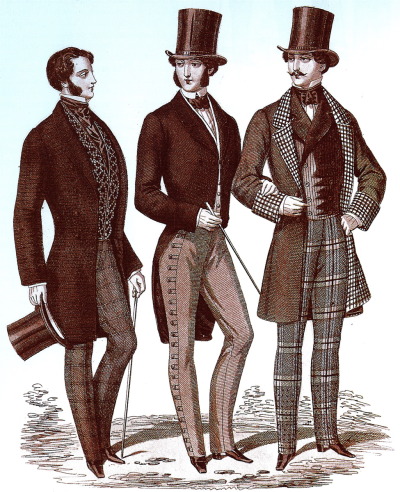 |
| The three piece suit |
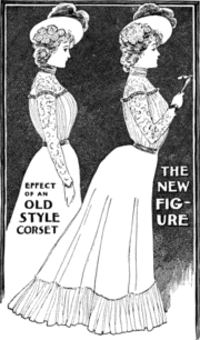 |
| Old magazine with the picture of 'The New S Curve' |
The Bathing Suit - The one piece bathing suit was introduced by Annette Kellerman which shocked the world.



 |
| All 1900's bathing suits |
1910 Fashion
Fashion in the years 1910–1919 is characterized by a rich and exotic luxury in the first half of the decade in contrast with the somber practicality of garments worn during the Great War. Men's trousers were worn cuffed to ankle-length and creased. Skirts rose from floor length to well above the ankle, women began to bob their hair, and the stage was set for the radical new fashions associated with the Jazz Age of the 1920s
The Hobble Skirt- French Designer Paul Poiret broke the new rule of freedom by designing the hobble skirt. The hemline was so narrow that women could only take very tiny steps and the pop spoke out in defence of the women, so poiret split the skirt to the knee bring a response of outrage from the public.
 |
The Hobble skirts
|
.jpg) |
Women's fashion industry expanded dramatically after the invention of the sewing machine in the mid-19th century. By 1910, the trend towards looser , lighter clothing picked up during this time. |
During and at the end of World War 1, The barrel silhouette or tonneau look came in. It is a baggy dress/jacket combination that made woman look large and droopy in the chest.
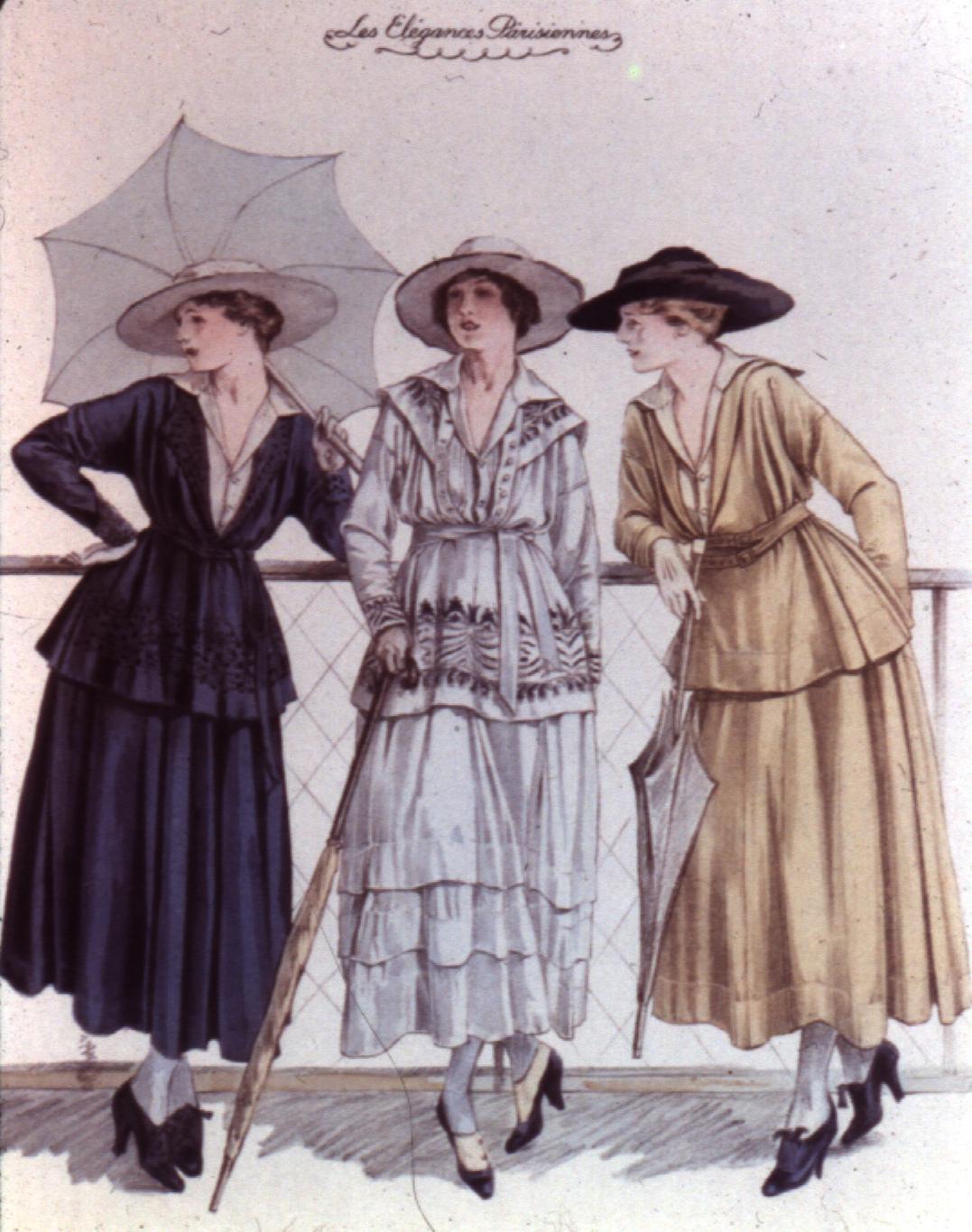 |
| The barrel silhouette |
The woman's movement demanded the right to vote, wear make up and cut their hair short for the first time in a Bobbed style and wear their skirts above the ankle.
 |
skirts above the ankle.
|
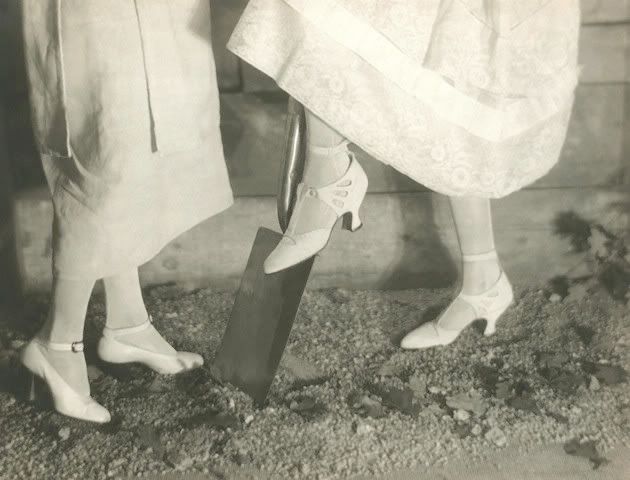 |
| above ankle |
1920's Fashion
Life began to move ahead fast. The fashion silhouette was straight up and down on tubular. Also the Brassiere was introduced, but it was used to flatten the figure, not uplift or to enhance it. There was also, safe makeup, costume jewellery and suntans were in great demand. (As I would still say to this day, we all demand a suntan still!)
Flappers Vs. Thinking Woman-
'The Flapper' wore a headband around her forehead, usually with a feather in front and her face was powdered, with her skirt shorter than any other in history. Her knees were also rouged. Silk stocking were the rage; they were rolled down just above the knee.
'The Thinking Woman' was college educated and considered herself to be the opposite of the flapper. Her dress was emancipated (Set free, especially from legal, social, or political restrictions) but not extreme.
 |
| Alice Joyce in dress |
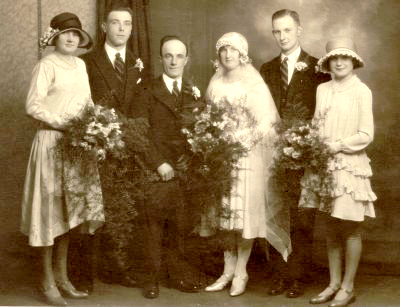 |
| More tubular shapes with a squarer top imitated the Egyptian style which was so popular after the discovery of Tuthankhamun's tomb in 1922. |
 |
| Violet Romer in Flapper dress |
 |
| A 'Flapper' on board a ship |
The Brassiere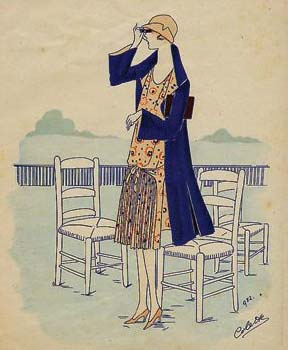 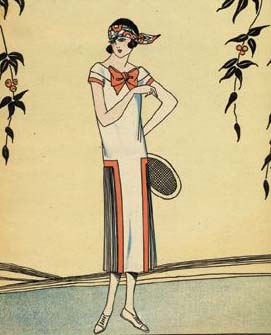  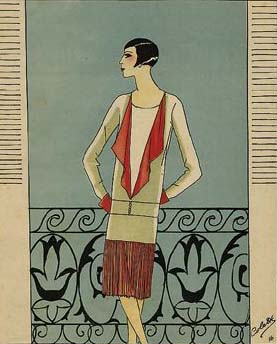 € €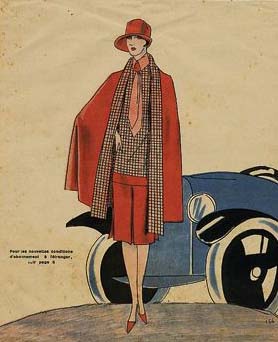 |
Influence of England -The Price had a big part in the ultimate trend setter of the 1920's. He often wore Oxford bags, extremely wide trousers which often reach 25 inches at the knee and cuffed at the bottom.
| Edward 8th, the social mediator of fashion. In a suit and and ascot at the neck |
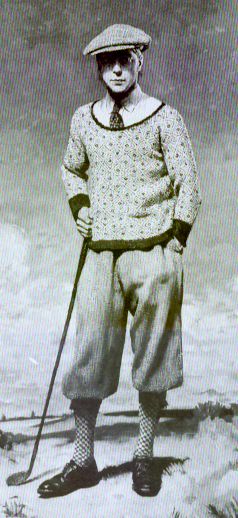 |
| cardigan sweater, argyle socks, wingtip shoes and a tie. |
1930's Fashion
The Depression Era-The 1930's was a time of depression, the Great Depression. The Great Depression lasted from the late 1920's all through the 30's. During this period, many people were unemployed, and many families didn't have much food.
The fashion of the 1930's was very different than the fashion today. Hats for both men and women were popular for both day and evening wear. Dresses were often cut of the 'bias' to allow a smoother drape of the fabric. Women wore long halter topped dresses, lace frocks, negligees, and corsets. Men wore suits with a matching top hat and over coats.
 |
| The great depression (top hats) |
 |
"Wanted Job"
|
Hemlines in the 1930's -
Hemlines went down and down again and by the of the 1930's fashion seemed to stand still in the shadow of impending war.
The Bias Cut - A bias cut garment is cut “on the bias,” which essentially means diagonally.Because they are cut diagonally, bias cut garments have a very different look from ordinary garments, even when the same basic pattern or shape is used. Bias cut garments tend to cling to a woman’s curves more than clothing that is cut normally, which gives bias cut dresses and nightgowns a reputation of being sexier than traditionally cut garments.
 |
| Bias cut out of silk |
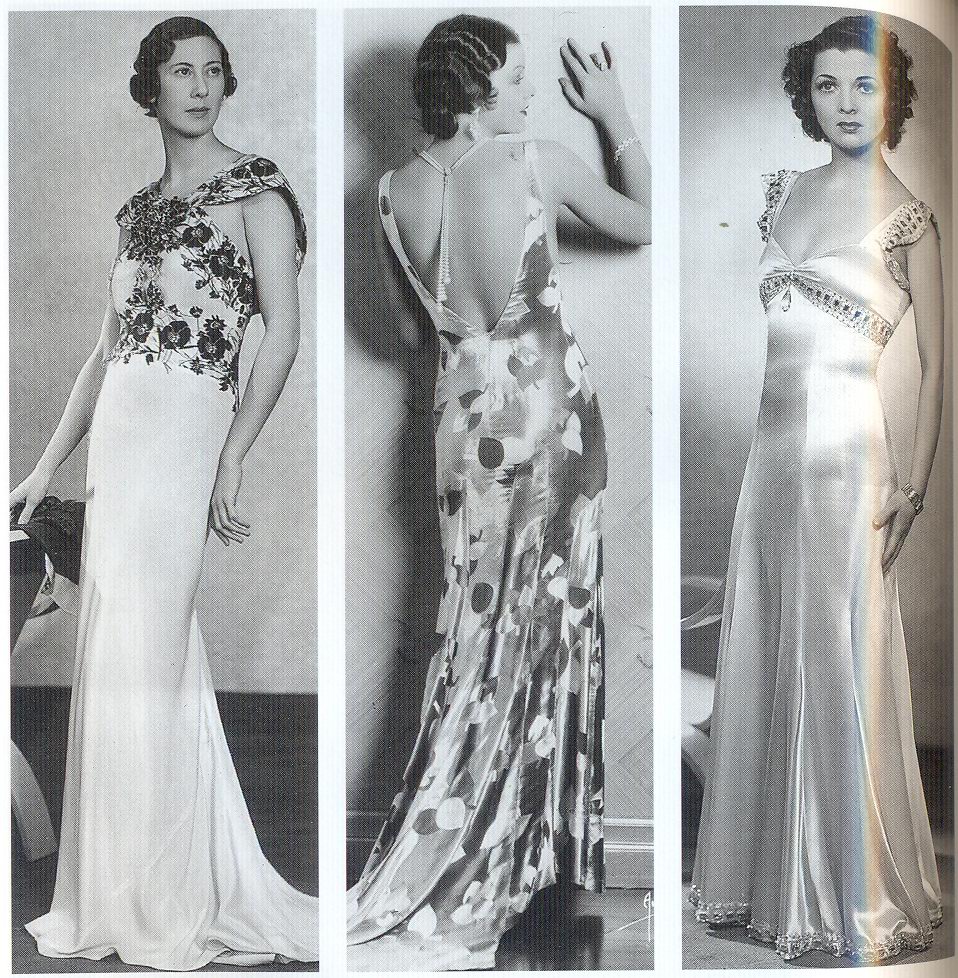 |
The Bias cut 1930's
|
1930 Sportswear
From the end of the 1930s through the 1940s, the New York fashion industry came into its own. Sportswear, which had evolved from its sporting origins to include simple casual wear for town and country, travel and leisure, was at the centre of this shift. Sportswear provided busy career women, college girls and housewives with clothes that could be worn on all occasions
"Wearing History"
|


|
 |
1940's Fashion
The war had much effect on fashion as clothes were in short supply and rationed. The government encouraged people to 'Make do and mend'. Older clothes were transformed into modern styles. Many women wore short skirts and sensible 'flat heeled' shoes and men wore trousers.

Land Girls
In March 1941 Ernest Bevin, Minister for Labour called on the women of Britain to help the war effort. Women stopped wearing fancy clothes and started wearing trousers or dungarees instead. They often wore a scarf which was tied around the head to protect against the risk of hair getting caught in the



1940's woman's trousers
The fashion was for Short skirts, and square shouldered jackets that recalled the cut of uniforms - these were the basic features of the wartime 'Utility fashions'.Heavy blankets were converted into fashionable overcoats and knitting was encouraged if you were able to get the wool or unpick an old jumper.
Not only fashion was restricted but food was rationed. The food was rationed from 1940-1954, however there was still some rationing after (D day)


How much food was one person allowed to buy per week during the war?
The weekly ration varied from month to month as foods became more or less plentiful.
A typical ration for one adult per week was:
| Butter: 50g (2oz) | Bacon and ham: 100g (4oz) | Margarine: 100g (4oz) |
| Sugar: 225g (8oz). | Meat: To the value of 1s.2d (one shilling and sixpence per week. That is about 6p today) | Milk: 3 pints (1800ml) occasionally dropping to 2 pints (1200ml). |
| Cheese: 2oz (50g) | Eggs: 1 fresh egg a week. | Tea: 50g (2oz). |
| Jam: 450g (1lb) every two months. | Dried eggs 1 packet every four weeks. | Sweets: 350g (12oz) every four weeks |
With the fashion industry closed down by the war in Europe, the USA was left to its own designers for fashion direction and the designers then turned to the military for inspiration.
'The Eisenhower' jacket made fashion history as it was adopted for civilian use. The shoulders were roomy and comfortable. 'The Bomber Jacket' was based on the air corpse flying coat made of leather with knit wrist cuffs to keep out the wind and it was usually lined with alpaca fur.
 |
Eisenhower Jacket's
|
 |
| 'WW2 The Eisenhower Jacket' |
.jpg) |
'The Bomber Jacket'
|
 |
'Fordand Lindbergh with onother type of bomber jacket'
|
1940's inverted triangle, broad shoulders and thin hips
The New Look
 |

|
The New Look
| What was the "New Look?" | |||
The "New Look" is most recognizable by its curvy shape and line, a far cry from its immediate predecessors. The desired look was a womanly hourglass figure, with a tiny waist, full hips, and a plentiful bust. Shoulders were no longer squared, but rounded and natural. Jackets were pinched in at the waist, and dresses had darts to accommodate the fabric increase from small waist to large chest and hips. Skirts were mid calf and full, flowing with layers of nylon petticoats. The freedom and grandeur of the skirts gave both a glamorous feeling and appearance. (Christian Dior) Hourglass figure (Christian Dior)   
| |||

1950's Fashion
Fashion was popular in the 1950s. Brightly coloured clothes and accessories became fashionable in the 1950s and the bikini was developed. 1950s fashion, like all fashion, reflected the fears and aspirations of its time. Two decades of deprivation and struggle were relieved by the threat of global nuclear war. Wartime restrictions and rations were removed, disappearing for most by the mid-1950s; in America, and parts of Europe, a new prosperity blossomed out of the ashes.
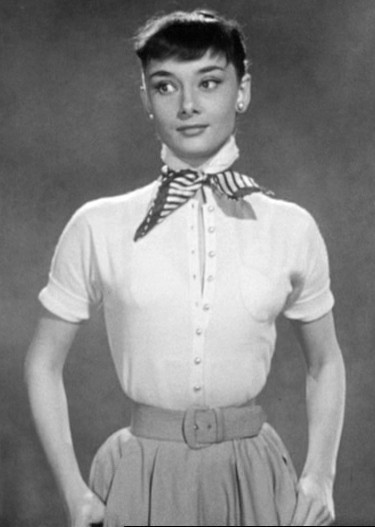
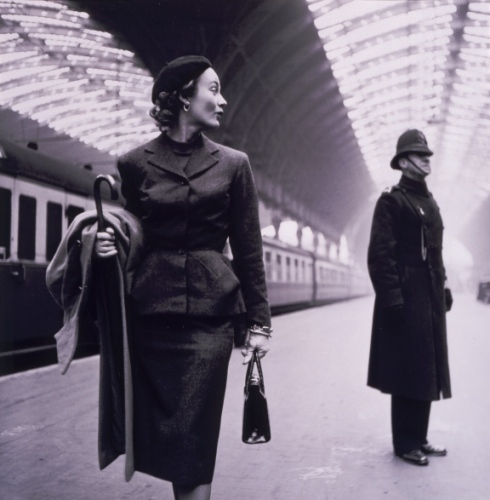

Dior would go on to invent more haute couture 1950s fashions, with names like the Princess Line, the Profile Line, the A Line, and the H Line. His influence remained high throughout the 1950s. Other fashion houses were forced to follow his innovations.


Christian Dior with his models in April 1950
Before the 1950s, underwear consisted of simple, white pieces of clothing which were not to be shown in public. In the 1950s, underwear came to be promoted as a fashion item in its own right, and came to be made in prints and coloursThe Bullet Bra (featuring exaggerated pointing or cone-shaped cups) and Push-Up Bra (by Frederick's Of Hollywood) all debuted during this decade. Women now appeared to have breasts that almost reached their necks!

Underwear in the 1950's


There was a strict dress code for eveningwear in the fifties. Early evening was for cocktail dress, and then there was the dinner dress and finally the more formal theatre dress suitable for a night time show. The full evening dress was opulent and modelled on a ball gown, only worn after 10pm and then on stately occasions. Dresses had deeply cut necklines, and could be strapless, backless or off-the-shoulder. Cocktail dresses were usually shorter then the more formal evening wear and not as low cut. They were made of silk, tulle, chiffon, satin, lace and net and came in single colours as well as abstract print. Some had bows, beads and sequins.

1950's gown dress's

cocktail dress (1950's)


evening dress
Nothing says 1950s fashion like circle skirts. These were worn by teenagers with many petticoats underneath. These were often homemade and were hand decorated with appliqués.

the circle skirts 1950's

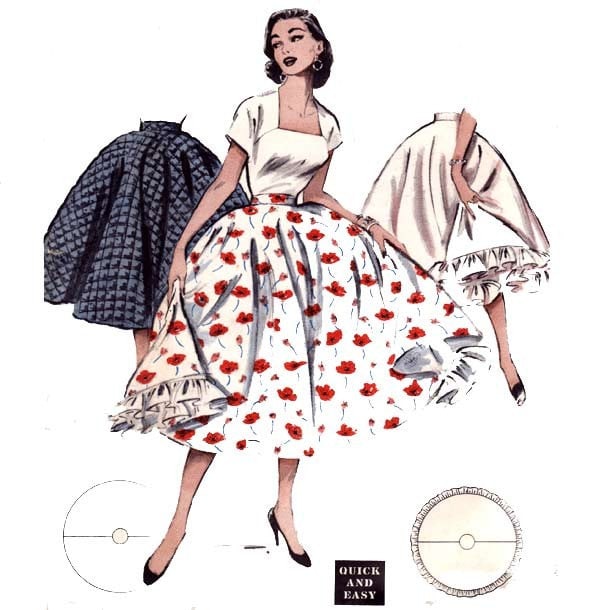
Teenagers and young people not wanting to conform became Rockers or Beatniks. These counter-culture groups had their own particular fashion. Ladies who favoured the Rocker style wore tight sweaters, very tight trousers, nipped in at the waist by elastic belts and spiked-heeled mules.

1950's rockers

1960's Fashion
The 1960s didn't start out with colorful clothes. They were dully designed and looked better on older people. Then little shops called boutiques opened selling cheap and colorful clothing for younger people. During the decade, women started wearing mini skirts, leather boots and fake eyelashes. Men wore Paisley shirts, velvet trousers and high collared Regency jackets. Men also began to wear their hair long.
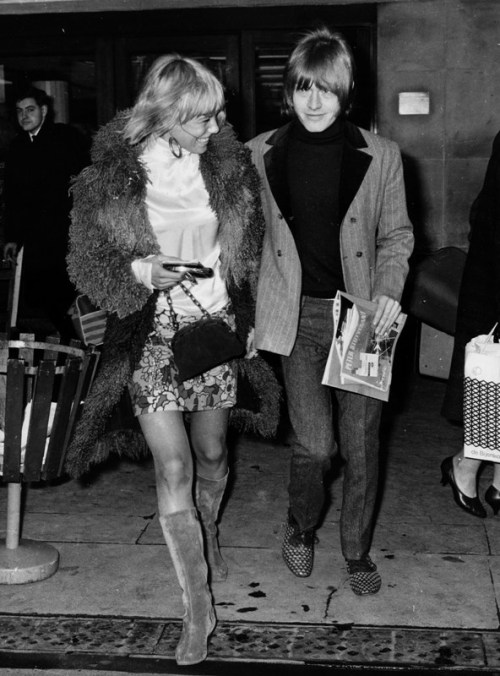
(Mini skirt and leather boots, Mens long hair)
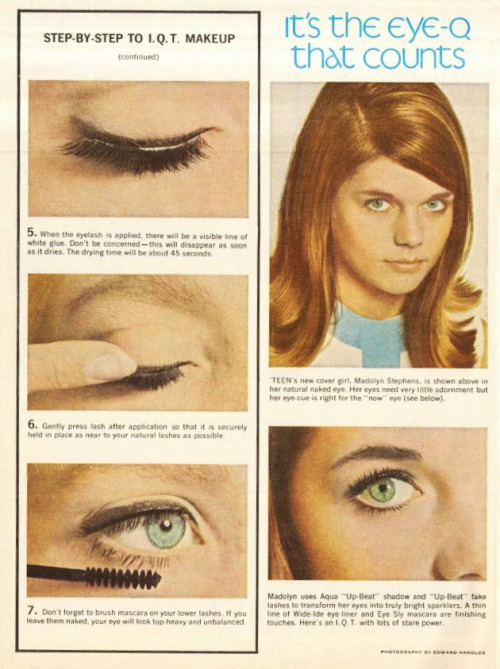
(long eyelashes - step by step guide 1968)
1960-1962 - At this time, there was a carry over from the 50's, including the "bouffant" look. A "bouffant" look is a dress where the top part is tight and the skirt of the dress puffs out. The popular hairstyle was a beehive, where they tease their hair and piled it high on their head. Another look during this time was the beatnik. The beat look included black berets, black slacks (tight for women) and dark glasses. Women wore float shoes while men wore sandals. Women wore dark eye makeup.

The Bouffant dress
 '#
'#The Beehive hairstyle
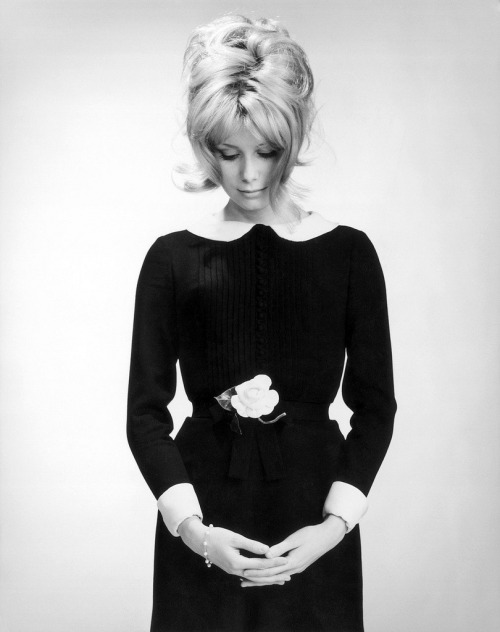

Beatnik (black berets)


